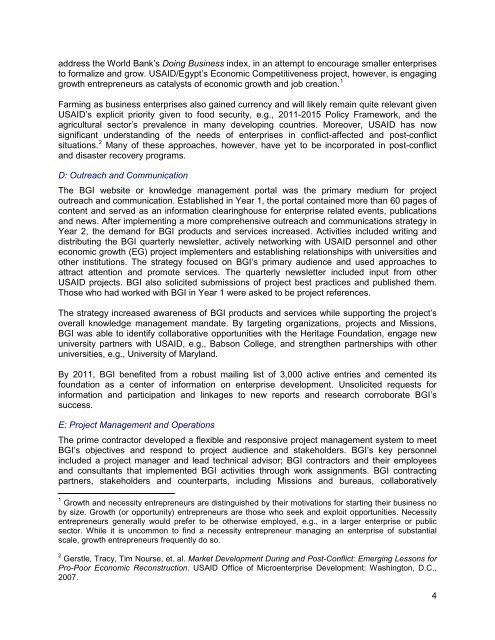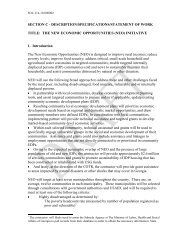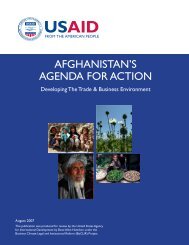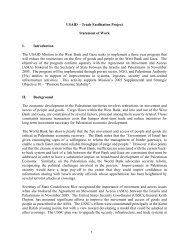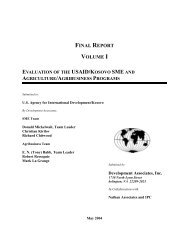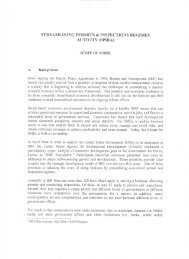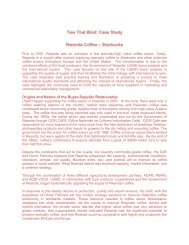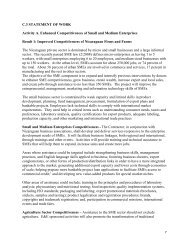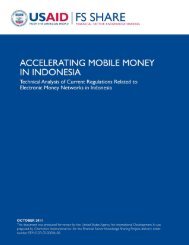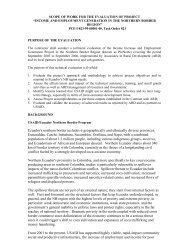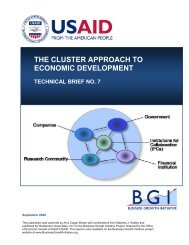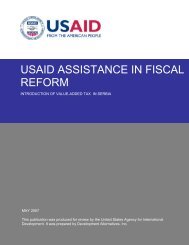BGI Final Report - Economic Growth - usaid
BGI Final Report - Economic Growth - usaid
BGI Final Report - Economic Growth - usaid
Create successful ePaper yourself
Turn your PDF publications into a flip-book with our unique Google optimized e-Paper software.
address the World Bank’s Doing Business index, in an attempt to encourage smaller enterprisesto formalize and grow. USAID/Egypt’s <strong>Economic</strong> Competitiveness project, however, is engaginggrowth entrepreneurs as catalysts of economic growth and job creation. 1Farming as business enterprises also gained currency and will likely remain quite relevant givenUSAID’s explicit priority given to food security, e.g., 2011-2015 Policy Framework, and theagricultural sector’s prevalence in many developing countries. Moreover, USAID has nowsignificant understanding of the needs of enterprises in conflict-affected and post-conflictsituations. 2 Many of these approaches, however, have yet to be incorporated in post-conflictand disaster recovery programs.D: Outreach and CommunicationThe <strong>BGI</strong> website or knowledge management portal was the primary medium for projectoutreach and communication. Established in Year 1, the portal contained more than 60 pages ofcontent and served as an information clearinghouse for enterprise related events, publicationsand news. After implementing a more comprehensive outreach and communications strategy inYear 2, the demand for <strong>BGI</strong> products and services increased. Activities included writing anddistributing the <strong>BGI</strong> quarterly newsletter, actively networking with USAID personnel and othereconomic growth (EG) project implementers and establishing relationships with universities andother institutions. The strategy focused on <strong>BGI</strong>’s primary audience and used approaches toattract attention and promote services. The quarterly newsletter included input from otherUSAID projects. <strong>BGI</strong> also solicited submissions of project best practices and published them.Those who had worked with <strong>BGI</strong> in Year 1 were asked to be project references.The strategy increased awareness of <strong>BGI</strong> products and services while supporting the project’soverall knowledge management mandate. By targeting organizations, projects and Missions,<strong>BGI</strong> was able to identify collaborative opportunities with the Heritage Foundation, engage newuniversity partners with USAID, e.g., Babson College, and strengthen partnerships with otheruniversities, e.g., University of Maryland.By 2011, <strong>BGI</strong> benefited from a robust mailing list of 3,000 active entries and cemented itsfoundation as a center of information on enterprise development. Unsolicited requests forinformation and participation and linkages to new reports and research corroborate <strong>BGI</strong>’ssuccess.E: Project Management and OperationsThe prime contractor developed a flexible and responsive project management system to meet<strong>BGI</strong>’s objectives and respond to project audience and stakeholders. <strong>BGI</strong>’s key personnelincluded a project manager and lead technical advisor; <strong>BGI</strong> contractors and their employeesand consultants that implemented <strong>BGI</strong> activities through work assignments. <strong>BGI</strong> contractingpartners, stakeholders and counterparts, including Missions and bureaus, collaboratively1 <strong>Growth</strong> and necessity entrepreneurs are distinguished by their motivations for starting their business noby size. <strong>Growth</strong> (or opportunity) entrepreneurs are those who seek and exploit opportunities. Necessityentrepreneurs generally would prefer to be otherwise employed, e.g., in a larger enterprise or publicsector. While it is uncommon to find a necessity entrepreneur managing an enterprise of substantialscale, growth entrepreneurs frequently do so.2 Gerstle, Tracy, Tim Nourse, et. al. Market Development During and Post-Conflict: Emerging Lessons forPro-Poor <strong>Economic</strong> Reconstruction. USAID Office of Microenterprise Development: Washington, D.C.,2007.4


